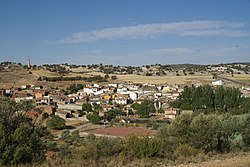Castile or Castille is a territory of imprecise limits located in Spain. The invention of the concept of Castile relies on the assimilation of a 19th-century determinist geographical notion, that of Castile as Spain's centro mesetario with a long-gone historical entity of diachronically variable territorial extension.

Castilla–La Mancha, or Castile La Mancha, is an autonomous community of Spain. Comprising the provinces of Albacete, Ciudad Real, Cuenca, Guadalajara and Toledo, it was created in 1982. The government headquarters are in Toledo, and its largest city is Albacete.

Cádiz is a province of southern Spain, in the southwestern part of the autonomous community of Andalusia. It is the southernmost part of mainland Spain, as well as the southernmost part of continental Europe.
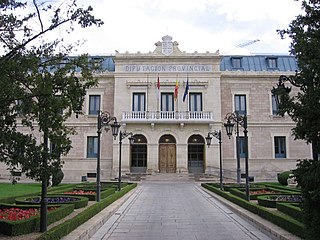
Cuenca is one of the five provinces of the autonomous community of Castilla-La Mancha. It is located in the eastern part of this autonomous community and covers 17,141 square km. It has a population of 203,841 inhabitants -- the least populated of the five provinces. Its capital city is also called Cuenca.
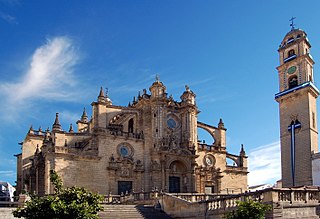
Jerez de la Frontera, or simply Jerez, is a Spanish city and municipality in the province of Cádiz in the autonomous community of Andalusia, in southwestern Spain, located midway between the Atlantic Ocean and the Cádiz Mountains. As of 2020, the city, the largest in the province, had a population of 213,105. It is the fifth largest in Andalusia, and has become the transportation and communications hub of the province, surpassing even Cádiz, the provincial capital, in economic activity. Jerez de la Frontera is also, in terms of land area, the largest municipality in the province, and its sprawling outlying areas are a fertile zone for agriculture. There are also many cattle ranches and horse-breeding operations, as well as a world-renowned wine industry (Xerez).

Cuenca is a city and municipality of Spain located in the autonomous community of Castilla–La Mancha. It is the capital of the province of Cuenca.
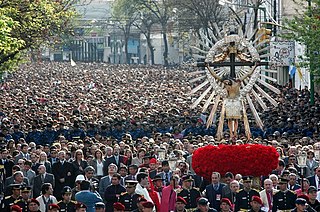
A Holy Week procession is a public ritual march of clergy and penitents which takes place during Holy Week in Christian countries, especially those with a Catholic culture. Various images of the saints, especially the Virgin Mary, and most importantly the image of the crucified Christ are carried aloft by foot on shoulder-borne pasos as an act of penance; acts of mortification are carried out; traditional Christian hymns and chants are sung. In many confraternities of penitents, the faces of the members are covered by elaborate hoods, such as the capirote, as a way of hiding one's identity in order to not ostentatiously draw attention to oneself while performing penance. Crosses, and biers holding Catholic holy images surrounded with flowers and offerings of candles, are carried usually from one parish church to another led by the clergy, monastic orders, or heads of the penitential orders.

The Biobío River is the second largest river in Chile. It originates from Icalma and Galletué lakes in the Andes and flows 380 km to the Gulf of Arauco on the Pacific Ocean.

San Cristóbal Verapaz is a town, with a population of 20,961, and a municipality in the Guatemalan department of Alta Verapaz. It is located approximately 29 km from Cobán, the capital of Alta Verapaz and about 210 km from Guatemala City. San Cristóbal belongs to the Pokimchi' linguistic area. Its main income source is the «Cobán» shoe factory, which specializes in industrial rubber boots, which are sold both locally and internationally.

Cañada Juncosa is a municipality in Cuenca, Castile-La Mancha, Spain. It has a population of 346.

Casas de Haro is a municipality in Cuenca, Castile-La Mancha, Spain. It has a population of 910.

Castillo-Albaráñez is a municipality in Cuenca, Castile-La Mancha, Spain. It has a population of 28.
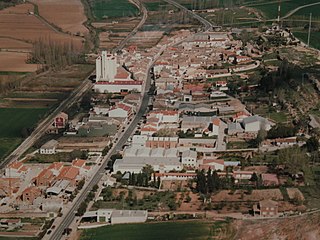
Chillarón de Cuenca is a municipality in located in the province of Cuenca, Castile-La Mancha, Spain. It has a population of 580 (2014).

Spanish Gothic architecture is the style of architecture prevalent in Spain in the Late Medieval period.
Alvia is a high-speed train service in Spain used by Renfe Operadora for long-distance service with a top speed of 250 km/h (160 mph). The trains have the ability to use both Iberian gauge and standard gauge, which allows them to travel on the recently constructed high-speed lines for part of the journey before switching to the "classic" Iberian gauge network to complete it. Trains that run exclusively on high-speed tracks are branded AVE or Avant.

The La Frontera Formation (Spanish: Formación La Frontera, K2F, Ksf) is a geological formation, part of the Villeta Group, of the Altiplano Cundiboyacense and neighbouring areas of the Eastern Ranges of the Colombian Andes. The sequence of limestones and lydites dates to the Late Cretaceous period; Turonian epoch and has a maximum thickness of 206 metres (676 ft).
The 1996 Vuelta a España was the 51st edition of the Vuelta a España, one of cycling's Grand Tours. The Vuelta began in Valencia on 7 September, and Stage 11 occurred on 18 September with a stage to Salamanca. The race finished in Madrid on 29 September.

Outlaws or The Laws of the Border is a 2021 Spanish film directed by Daniel Monzón adapting the novel of the same name by Javier Cercas. It stars Marcos Ruiz, Begoña Vargas and Chechu Salgado.

Paradores de Turismo de España S.M.E.S.A., branded as Paradores, is a Spanish state-owned chain of luxury hotels that are usually located in historic buildings or in nature areas with a special appeal. Its very first parador was inaugurated on 9 October 1928 in Navarredonda de Gredos (Ávila). As of 2022, it operates ninety-seven paradors in Spain and one in Portugal, with 5,988 rooms in total. Every parador has its own restaurant offering the regional gastronomy of its area.
